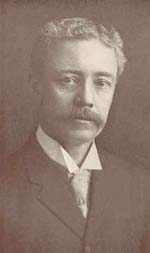In the original curriculum of the college, astronomy was included as a required course for the junior year. The college elected its first physics professor, Clement Daniel Fishburne, on August 23, 1854 and appointed him Chair of Natural Philosophy and Astronomy. By 1900, the number of course offerings in physics had expanded to four, and all freshmen were required to take one full year of physics.
 |
|
Dr. Henry Louis Smith
|
Laboratory work did not become the focus of the physics classes until the junior and senior years. The 1899-1900 college catalogue states that the junior class physics course is “confined to the department of Electricity [with a great supply of] Voltmeters, Ammeters, Wheatstone’s Bridges, Wireless Telegraphy Apparatus, and the largest X-Ray outfit in the State . . . all these are used by the members of the class, and explained by numerous lectures.” The senior physics class, meanwhile, focused on the “use of maps, charts, globes, apparatus for the projection of astronomical phenomena, sextant, and a Clark & Sons’ Refracting Telescope.” One of the most exciting developments of the physics department during the late 1800’s was the invention of the X-Ray photograph. Dr. Henry Louis Smith, a native of Greensboro, North Carolina, had accepted a position as Professor of Physics for Davidson College in 1887. He eventually became President of the college in 1901. During his time at Davidson, Smith performed one of the first X-Ray experiments in the United States. In February 1896, he published his X-Ray photograph of a bullet in the hand of a cadaver in the Charlotte Observer.
Three of Smith’s students, Osmond L. Barringer, Eben Hardie, and E. Pender Porter, also produced one of the first X-Ray photographs in the United States, although quite illegally. On the night of January 12, 1896, the three students bribed a janitor to let them into the medical laboratory on campus. After three hours of experimenting, they produced an X-Ray photograph of two .22 caliber rifle cartridges, two rings and a pin inside a pillbox, and of a human finger they had sliced from a cadaver with a pocketknife. “We kept our picture and escapade a secret and it was not until later that we realized we were making history for the college instead of just breaking the rules,” Barringer wrote years later.
In 1919-1920, the physics department consisted of one full-time professor. By 1929-1930, the college had hired two additional professors, bringing the total number up to three. In 1998, the department consisted of four full professors, one associate professor, one assistant professor and two visiting assistant professors.
Biology, Chemistry, Mathematics, North Carolina Medical College, Physics – Bibliography
Beaty, Mary D. A History of Davidson College. Davidson, N.C.: Briarpatch, 1988.
Cromartie, Caroline King. The Physical Development of Davidson, North Carolina: An Historical Analysis. Davidson College Honors Thesis, 1978.
Davidson, Chalmers Gaston. “Davidson Celebrates.” Davidson Journal 1 (1987): 2-7.
Davidson, Chalmers Gaston. Mid-Point for ’28. Davidson, N.C.: Davidson College, 1953.
Kelley, Robert Lincoln. Davidson College: A Diagnosis and a Prescription. Lancaster, PA: Council of Church Boards of Education in the U.S.A., 1926.
Lingle, Walter L. Memories of Davidson College. Richmond, VA: John Knox, 1947.
Logan, Van Lear. “Growing Up in Davidson.” Davidson Journal 1 (1987): 20-23.
Ratliff, Charles E. Economics at Davidson: A Sesquicentennial History. Davidson, NC: Davidson College, 1987.
Shaw, Cornelia Rebekah. Davidson College. New York: Fleming H. Revell, 1923.
Spencer, Samuel R. The First Year. Davidson, NC: Davidson College, 1969.
Author: Molly Gillespie
Date: 1998
Cite as: Gillespie, Molly. “Physics Department ” Davidson
Encyclopedia 1998 <https://davidsonarchivesandspecialcollections.org/archives/encyclopedia/physics-department/>
Related Entries: Historic
Buildings, Smith, Henry Louis

Sorry, comments are closed for this post.